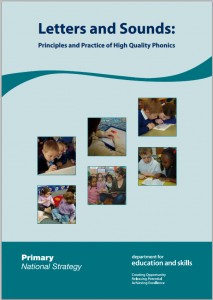Part One – The Basis for the Critique
Is further national and international perpetuation of the use of the ‘Letters and Sounds: Principles and Practice of High Quality Phonics Six-phase Teaching Programme’ as a programme in reality a current and classic example of the Naked Emperor?

Note that I have included the word publication in the title of this critique as this is one aspect that I am going to examine – the criteria for a publication to qualify as ‘a programme’ – along with other issues relating to the historic events, the content, and the delivery of ‘Letters and Sounds’ in our schools, and the use of ‘Letters and Sounds’ in our universities for training student-teachers in England – and further, the perpetuation of this publication in England and overseas.
My interest in teaching methods and their effectiveness extends to an international perspective– and increasingly I note that ‘Letters and Sounds’ is not only regarded as a leading publication in England – but also around the world, for example in international schools and in whole regions such as Western Australia.
Here are examples of questions that I suggest need asking:
- Does ‘Letters and Sounds’ qualify as a programme?
- Are the principles and practice underpinning ‘Letters and Sounds’ up-to-date and evidence-based?
- Is the content adequate, and are the suggestions for games and activities adequate and deliverable, and are the time-scales adequate, to support teachers in providing mainstream and special needs teaching over a period of broadly four years for whole classes and individuals (approximately three year olds to seven year olds – in England this would equate to Foundation Stage One and Two, and Key Stage One)?
- In the light of the passage of time (at the time of writing, six years following the publication), can we identify and understand any particularly positive or negative features in ‘Letters and Sounds’ to address for our continuing professional development?
- Further, can we recognize any patterns of practice of teachers’ translation of the guidance in our schools in positive and/or negative ways – and, if so, how can teachers adjust their practice accordingly for potentially greater benefits?
- Can we identify features of teacher-training in our universities and in-service training associated with ‘Letters and Sounds’ which is, or is not, sufficiently in-depth to move the teaching profession forwards?
- Do professionals (e.g. teachers/advisors/inspectors/trainers/curriculum developers) have sufficient knowledge and capacity to be able to evaluate, compare and contrast features and results, or likely results, of ‘Letters and Sounds‘ and of phonics programmes – commercial or in-house?
- Does professional development include support and capacity for teachers – and others – to evaluate, compare and contrast programme-content and teacher-practices of any phonics programmes and practices?
- Are the universities associated with teacher-education looking into the range of relevant issues such as those above?
Thus, the imperative in my mind for this critique is based on my particular interest and specialism in the field of literacy, my personal opinion regarding the content of ‘Letters and Sounds’ on a practical level, my observations in some schools in England and overseas of the translation by teachers of ‘Letters and Sounds’ guidance into practice and the hardship for teachers and children that this is in danger of causing, and my concern regarding teachers’ professional development in terms of building on findings to date – in other words, I suggest that there are dangers inherent in ‘treading water’ or being complacent on any level.
This multi-part posting will form the basis of a detailed critique of the ‘Letters and Sounds’ publication which I shall eventually provide as a one-piece paper. In truth, I think a detailed and deep evaluation is potentially so important for moving the education profession forwards that I perceive any evaluation must be as objective as possible (when in reality no one person can be truly objective). For the critique to have any value, it needs to be very detailed and not superficial in order to evidence opinion as far as is practicable – my critique itself must stand up to scrutiny.
I suggest that a critique was needed from the outset of ‘Letters and Sounds’ being rolled out in 2007 – when it was provided as multiple copies of free hard-copy material in infant and primary schools in England and presented as a possible ‘programme of choice’. With the weight and authority of this being presented as the government ‘programme’ and the climate of ‘what would Ofsted [inspectors] want to see’ setting the scene – and the fact it was free of charge therefore to all intents and purposes with no associated commercial vested interests, naturally many schools ‘chose’ to base their phonics provision on ‘Letters and Sounds’. What has been the effect of this?
What is the effect now?
It is important, however, to understand the important sequence of events leading up to the publication of ‘Letters and Sounds’ which is, no-one can deny, a landmark document.
Part Two to follow shortly…